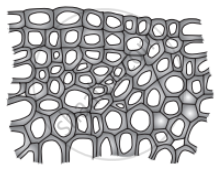Advertisements
Advertisements
Question
What are permanent tissues? Describe the different types of simple permanent tissues.
Solution
Permanent tissues are those in which, growth has stopped either completely or for the time being. At times, they become meristematic partially or wholly. Permanent tissues are of two types namely
- simple tissue and
- complex tissue.
1. Simple Tissues:
Simple tissue are homogeneous-composed of structurally and functionally similar cells eg., Parenchyma, Collenchyma, and Sclerenchyma.
i) Parenchyma
Types of Prenchyma

Parenchyma are simple permanent tissue composed of living cells. Parenchyma cells are thin-walled, oval, rounded or polygonal in shape with well-developed spaces among them. In aquatic plants. Parenchyma possesses intercellular air spaces and is named as Aerenchyma. When exposed to light, parenchyma cells may develop chloroplasts and are known as Chlorenchyma.
Functions: Parenchyma may store water in many succulent and xerophytic plants. It also serves the functions of storage of food reserves, absorption, buoyancy, secretion etc.
ii) Collenchyma

Collenchyma is a living tissue found beneath the epidermis.
Cells are elongated with unevenly thickened non-lignified walls.
Cells have rectangular oblique or tapering ends and persistent protoplasts. They possess thick primary non-lignified walls.
Functions: They provide mechanical support for growing organs.
iii) Sclerenchyma

Sclerenchyma consists of thick-walled cells which are often lignified. Sclerenchyma cells do not possess living protoplasts at maturity.
Sclerenchyma cells are grouped into
- fibres and
- Sclereids.
- Fibres are elongated sclerenchymatous cells, usually with pointed ends. Their walls are lignified. Fibres are abundantly found in many plants. The average length of fibres is 1 to 3 mm, however in plants like Linum usitatissimum (flax), Cannabis sativa (hemp) and Corchorus capsularis (jute), fibres are extensively longer ranging from 20 mm to 550 mm.
- Sclereids are widely distributed in plant body. They are usually broad, may occur in single or in groups. Sclereids are isodiametric, with liginified walls. Pits are prominent and seen along the walls. Lumen is filled with wall materials. Sclereids are also common in fruits and seeds.
APPEARS IN
RELATED QUESTIONS
Fill in the blank by selecting suitable words from the list given below:
Xylem and phloem form the ............... tissue.
Name the kind of tissue that Transports food to different parts of plant
Name the kind of tissue that Transports water in plants
Fill in the blank
........................ tissue consists of more than one kind of cells.
Fill in the blank
............... is a complex tissue that distributes food in plants.
Write the differences.
Simple tissue and complex tissue in plants.
______ and ______ are complex tissues.
What is complex tissue? Name the various kinds of complex tissues.
Choose the wrong statement
Which of the following is NOT true?
